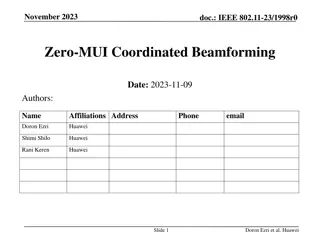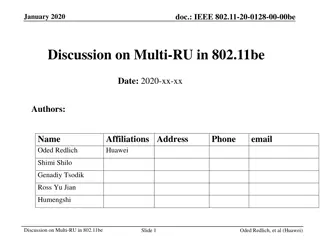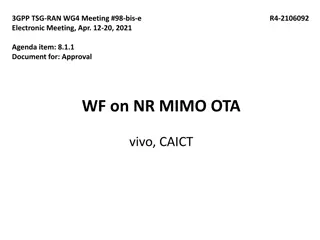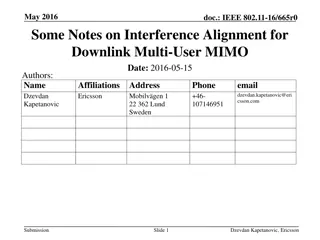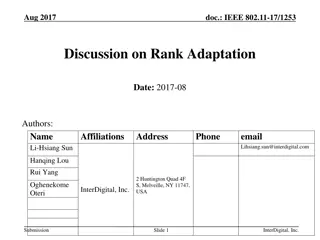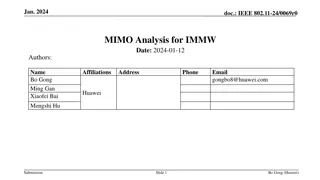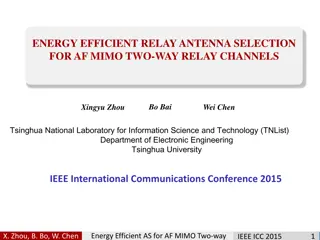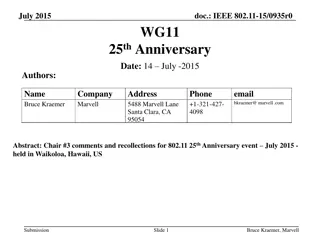IEEE 802.11 MU-MIMO Considerations and Test Results
This document from January 2021 discusses considerations and test results related to IEEE 802.11 MU-MIMO (Multi-User Multiple Input Multiple Output) technology. It covers field test results, test setups, test scenarios, observations, and conclusions regarding supported NSS (Number of Spatial Streams) and MCS (Modulation and Coding Scheme) levels for both single-user (SU) and multi-user (MU) modes.
Download Presentation

Please find below an Image/Link to download the presentation.
The content on the website is provided AS IS for your information and personal use only. It may not be sold, licensed, or shared on other websites without obtaining consent from the author.If you encounter any issues during the download, it is possible that the publisher has removed the file from their server.
You are allowed to download the files provided on this website for personal or commercial use, subject to the condition that they are used lawfully. All files are the property of their respective owners.
The content on the website is provided AS IS for your information and personal use only. It may not be sold, licensed, or shared on other websites without obtaining consent from the author.
E N D
Presentation Transcript
January 2021 doc.: IEEE 802.11-21/0102r2 Considerations on Capabilities and Operation Mode: MU-MIMO Date: 2021-01-18 Authors: Name Affiliations Address Phone email Wook Bong Lee Samsung wookbong.lee@Samsung.com Pavan Veerashetty Samsung Junghoon Suh Huawei Junghoon.Suh@huawei.com Jinsoo Choi LG js.choi@lge.com Submission Slide 1 Wook Bong Lee, Samsung
January 2021 doc.: IEEE 802.11-21/0102r2 Introduction In this contribution, we provided 11ax MU-MIMO field test results and we discussed issues and proposed solutions for 11be Revision 1: updated proposed OM field, A-Control, SPs are modified accordingly Submission Slide 2 Wook Bong Lee, Samsung
January 2021 doc.: IEEE 802.11-21/0102r2 Test Setup AP: 4 transmit antennas This AP schedules Nss = [2, 2] using MU-MIMO when there are two non-AP STAs with Nss 2 reception capabilities Non-AP STA: 2 receive antennas and capable of MCS 11 for Nss = 2 Run downlink throughput test MU mode: two non-AP STAs connected to the AP SU mode: single non-AP STA connected to the AP Submission Slide 3 Wook Bong Lee, Samsung
January 2021 doc.: IEEE 802.11-21/0102r2 Test Results Test scenarios Three test cases: different Supported HE-MCS And NSS Set Case1: HE-MCS 0-7 Nss = 2 Case2: HE-MCS 0-9 Nss = 2 Case3: HE-MCS 0-11 Nss = 2 Sum Throughput / Case 3 Sum Throughput Number of MPDU Errors Case 1 96.2 % 41 Case 2 99.9 % 7959 Case 3 100 % 138043 With the same test setup, device could support Nss 2 with MCS 11 with almost no error in SU case Observation: Nss = [2, 2] with higher MCS level suffers from inter-stream interference. In this case, it is better to support only Nss = 2 HE-MCS 0-9 (only for MU) Submission Slide 4 Wook Bong Lee, Samsung
January 2021 doc.: IEEE 802.11-21/0102r2 Test Results 2 Test scenarios Two test cases: Supported HE-MCS And NSS Set Case1: HE-MCS 0-11 Nss = 2 Case2: One device: HE-MCS 0-11 Nss = 2, Other device: HE-MCS 0-11 Nss = 1 (still two receive antennas) Case 2 / Case 1 Test 1 100% Test 2 107.4% Test 3 114.2% Observation: reducing total number of stream helps to improve throughput Submission Slide 5 Wook Bong Lee, Samsung
January 2021 doc.: IEEE 802.11-21/0102r2 Supported NSS and MCS level 11ax does not distinguish between SU and MU supported NSS and MCS level. When there is no inter-stream interference, indeed, a non-AP STA can support same NSS and MCS level for SU and MU operation. However, when there is inter-stream interference, (depending on interference level) supported NSS and MCS level for MU can be smaller than SU case. Note that inter-stream interference level can be increased as time between sounding and data transmission increased. We propose to have two different set of Supported NSS and MCS level and separate Rx NSS can be updated by e.g. OMI (OM Control) Submission Slide 6 Wook Bong Lee, Samsung
January 2021 doc.: IEEE 802.11-21/0102r2 What will be impact? (AP point of view) AP needs to have two sets of non-AP STA capabilities for (Rx Nss, MCS). Note that High MCS level is sensitive to additional interference For example, 1024 QAM and 4K QAM may be not suitable for MU-MIMO when using all of antennas to receive its spatial streams, e.g. MU-MIMO with Nss = 2, MCS 10 to 13 when non- AP STA has two receive antennas Link adaptation point of view, SU and MU show quite different performance anyway, so two different (Rx Nss, MCS) (link adaptation results) should be fine. However, AP may need to update algorithm for switching between SU and MU Updating MU Nc may result in re-grouping and re-sounding AP can apply update MU Nc from next sounding which means MU Nc update only applied for sounding procedure (Max Nc value for MU) We can also think about following AP capabilities (two bits) to accept different Nss for SU and MU to accept different MCS for SU and MU to accept different Nss and MCS for SU and MU Submission Slide 7 Wook Bong Lee, Samsung
January 2021 doc.: IEEE 802.11-21/0102r2 What will be impact? (Performance point of view) There is no difference for 1x1 non-AP STA. In the worst case (if all non-AP STA reduce its MU-MIMO Rx Nss to 1), High SNR: performance will be the same as SU-MIMO If the channel condition is not supporting Nss=2 MCS 11 for SU, the MU performance will be better than SU. Note that in many case, two user with single stream each will provide much higher throughput than SU two stream case as the transmitter can suppress inter stream interference more using its extra degree of freedom (e.g. 4 Tx to 2 streams or 3 streams) and the receiver can suppress inter stream interference using its extra degree of freedom (e.g. 2 antennas to receive one spatial steam and suppress other steam interference) Moreover, non-AP STA with more than two receive antennas (high throughput demanding STAs) will try its best to have better throughput in MU-MIMO. So, it won t reduce MU-MIMO Rx Nss unless it is beneficial for the STA. If changing MU-MIMO Rx Nss is beneficial for the STA, then it is beneficial for network throughput as well. Submission Slide 8 Wook Bong Lee, Samsung
January 2021 doc.: IEEE 802.11-21/0102r2 SU and MU Rx EHT MCS Map Two sets of Rx EHT-MCS Map Rx EHT-MCS Map indicates the maximum value of the maximum MCS that can be received by the STA for each number of spatial stream using SU-MIMO MU-MIMO Rx EHT-MCS Map indicates the maximum value of the maximum MCS that can be received by the STA for each number of spatial stream using MU-MIMO Tx EHT-MCS Map indicates the maximum value of the maximum MCS that can be transmitted by the STA for each number of spatial stream using either SU or MU-MIMO MU-MIMO Rx EHT-MCS Map 80 MHz MU-MIMO Rx EHT-MCS Map 160 MHz MU-MIMO Rx EHT-MCS Map 320 MHz Rx EHT-MCS Map 80 MHz Tx EHT-MCS Map 80 MHz Rx EHT-MCS Map 160 MHz Tx EHT-MCS Map 160 MHz Rx EHT-MCS Map 320 MHz Tx EHT-MCS Map 320 MHz Octets: 4 1 4 0 or 4 0 or 1 0 or 4 0 or 4 0 or 1 0 or 4 Submission Slide 9 Wook Bong Lee, Samsung
January 2021 doc.: IEEE 802.11-21/0102r2 Rx/Tx EHT MCS Map Need to support 16 spatial stream (in R2), and MCS level is now increased to 15 So, each subfield can be 4 Byte with following format B0 B1 Max EHT-MCS For 1 SS 2 B2 B3 Max EHT-MCS For 2 SS 2 B4 B5 Max EHT-MCS For 3 SS 2 B6 B7 Max EHT-MCS For 4 SS 2 B8 B9 Max EHT-MCS For 5 SS 2 B10 B11 Max EHT-MCS For 6 SS 2 B12 B13 Max EHT-MCS For 7 SS 2 B14 B15 Max EHT-MCS For 8 SS 2 Bits: B16 B17 Max EHT-MCS For 9 SS 2 B18 B19 Max EHT-MCS For 10 SS 2 B20 B21 Max EHT-MCS For 11 SS 2 B22 B23 Max EHT-MCS For 12 SS 2 B24 B25 Max EHT-MCS For 13 SS 2 B26 B27 Max EHT-MCS For 14 SS 2 B28 B29 Max EHT-MCS For 15 SS 2 B30 B31 Max EHT-MCS For 16 SS 2 Bits: For 20 MHz only STA, 0 indicates support for EHT-MCS 0-7 for n spatial streams, for 1 spatial stream it includes EHT-MCS 15 1 indicates support for EHT-MCS 0-9 for n spatial streams, for 1 spatial stream it includes EHT-MCS 15 2 indicates support for EHT-MCS 0-11 for n spatial streams, for 1 spatial stream it includes EHT-MCS 15 3 indicates that n spatial streams is not supported for EHT PPDUs For other STA 0 indicates support for EHT-MCS 0-9 for n spatial streams, for 1 spatial stream it includes EHT-MCS 15 1 indicates support for EHT-MCS 0-11 for n spatial streams, for 1 spatial stream it includes EHT-MCS 15 2 indicates support for EHT-MCS 0-13 for n spatial streams, for 1 spatial stream it includes EHT-MCS 15 3 indicates that n spatial streams is not supported for EHT PPDUs Note: EHT-MCS 14 can be indicated separately Submission Slide 10 Wook Bong Lee, Samsung
January 2021 doc.: IEEE 802.11-21/0102r2 MU-MIMO Rx EHT MCS Map MU-MIMO supports up to 4 SS So, each subfield can be 1 Byte with following format B0 B1 Max EHT-MCS For 1 SS 2 B2 B3 Max EHT-MCS For 2 SS 2 B4 B5 Max EHT-MCS For 3 SS 2 B6 B7 Max EHT-MCS For 4 SS 2 Bits: For 20 MHz only STA, 0 indicates support for EHT-MCS 0-7 for n spatial streams 1 indicates support for EHT-MCS 0-9 for n spatial streams 2 indicates support for EHT-MCS 0-11 for n spatial streams 3 indicates that n spatial streams is not supported for EHT PPDUs For other STA 0 indicates support for EHT-MCS 0-9 for n spatial streams 1 indicates support for EHT-MCS 0-11 for n spatial streams 2 indicates support for EHT-MCS 0-13 for n spatial streams 3 indicates that n spatial streams is not supported for EHT PPDUs Submission Slide 11 Wook Bong Lee, Samsung
January 2021 doc.: IEEE 802.11-21/0102r2 Extended Operating Mode Notification Frame Format Proposal is to add an extended operating mode notification frame action field format as follows Order 1 2 3 Information Category EHT Extended Operating Extended Operating Mode can also be defined as standalone IE to be included in beacon and Probe response frame Submission Slide 12 Wook Bong Lee, Samsung
January 2021 doc.: IEEE 802.11-21/0102r2 Extended Operating Mode The Rx NSS indicates the maximum number of spatial streams that the STA supports in reception using SU-MIMO The MU-MIMO Rx NSS indicates the maximum number of the Nc subfield when Feedback Type And Ng subfield and Codebook Size subfield indicates MU feedback 11be support more bandwidth option, we can have separate Rx NSS subfields for each bandwidth option B0 B2 Channel Width 3 B3 B4 B7 B8 B9 B10 No LDPC Rx NSS MU Nc Rx NSS Type Bits: 1 4 2 1 Example of Operating Mode field format Submission Slide 13 Wook Bong Lee, Samsung
January 2021 doc.: IEEE 802.11-21/0102r2 Extended Operating Mode Control As part of A-Control A new A-Control field which has the functionality of existing OM Control Can be defined to accommodate this new field which looks as follows B0 B3 B4 B5 B6 B8 B9 Rx NSS MU Nc Channel Width UL MU Disable Bits: 4 2 3 1 B10 B13 B14 B15 B16 DL MU-MIMO Resound Recommendation UL MU Data Disable TX NSS ER SU Disable Bits: 4 1 1 1 Example of Extended OM Control format Submission Slide 14 Wook Bong Lee, Samsung
January 2021 doc.: IEEE 802.11-21/0102r2 SP #1 Do you support different (MCS, NSS) capabilities for SU and MU- MIMO? Y/N/A Submission Slide 15 Wook Bong Lee, Samsung
January 2021 doc.: IEEE 802.11-21/0102r2 SP #2 Do you support to define the following as a Supported EHT-MCS And NSS field? SU Rx EHT-MCS Map indicates the maximum value of the maximum MCS that can be received by the STA for each number of spatial stream using SU- MIMO MU Rx EHT-MCS Map indicates the maximum value of the maximum MCS that can be received by the STA for each number of spatial stream using MU- MIMO Tx EHT-MCS Map indicates the maximum value of the maximum MCS that can be transmitted by the STA for each number of spatial stream using either SU or MU-MIMO MU-MIMO Rx EHT-MCS Map 80 MHz MU-MIMO Rx EHT-MCS Map 160 MHz MU-MIMO Rx EHT-MCS Map 320 MHz Rx EHT-MCS Map 80 MHz Tx EHT-MCS Map 80 MHz Rx EHT-MCS Map 160 MHz Tx EHT-MCS Map 160 MHz Rx EHT-MCS Map 320 MHz Tx EHT-MCS Map 320 MHz Octets: 4 1 4 0 or 4 0 or 1 0 or 4 0 or 4 0 or 1 0 or 4 Y/N/A Submission Slide 16 Wook Bong Lee, Samsung
January 2021 doc.: IEEE 802.11-21/0102r2 SP #3 Do you support to define the following as an Rx/Tx EHT MCS Map subfields? For 20 MHz only STA, 0 indicates support for EHT-MCS 0-7 for n spatial streams, for 1 spatial stream it includes EHT-MCS 15 1 indicates support for EHT-MCS 0-9 for n spatial streams, for 1 spatial stream it includes EHT-MCS 15 2 indicates support for EHT-MCS 0-11 for n spatial streams, for 1 spatial stream it includes EHT-MCS 15 3 indicates that n spatial streams is not supported for EHT PPDUs For other STA 0 indicates support for EHT-MCS 0-9 for n spatial streams, for 1 spatial stream it includes EHT-MCS 15 1 indicates support for EHT-MCS 0-11 for n spatial streams, for 1 spatial stream it includes EHT-MCS 15 2 indicates support for EHT-MCS 0-13 for n spatial streams, for 1 spatial stream it includes EHT-MCS 15 3 indicates that n spatial streams is not supported for EHT PPDUs Note: EHT-MCS 14 can be indicated separately B0 B1 Max EHT-MCS For 1 SS 2 B2 B3 Max EHT-MCS For 2 SS 2 B4 B5 Max EHT-MCS For 3 SS 2 B6 B7 Max EHT-MCS For 4 SS 2 B8 B9 Max EHT-MCS For 5 SS 2 B10 B11 Max EHT-MCS For 6 SS 2 B12 B13 Max EHT-MCS For 7 SS 2 B14 B15 Max EHT-MCS For 8 SS 2 Bits: B16 B17 Max EHT-MCS For 9 SS 2 B18 B19 Max EHT-MCS For 10 SS 2 B20 B21 Max EHT-MCS For 11 SS 2 B22 B23 Max EHT-MCS For 12 SS 2 B24 B25 Max EHT-MCS For 13 SS 2 B26 B27 Max EHT-MCS For 14 SS 2 B28 B29 Max EHT-MCS For 15 SS 2 B30 B31 Max EHT-MCS For 16 SS 2 Bits: Y/N/A Submission Slide 17 Wook Bong Lee, Samsung
January 2021 doc.: IEEE 802.11-21/0102r2 SP #4 Do you support to define the following as an MU-MIMO Rx EHT MCS Map subfields? For 20 MHz only STA, 0 indicates support for EHT-MCS 0-7 for n spatial streams 1 indicates support for EHT-MCS 0-9 for n spatial streams 2 indicates support for EHT-MCS 0-11 for n spatial streams 3 indicates that n spatial streams is not supported for EHT PPDUs For other STA 0 indicates support for EHT-MCS 0-9 for n spatial streams 1 indicates support for EHT-MCS 0-11 for n spatial streams 2 indicates support for EHT-MCS 0-13 for n spatial streams 3 indicates that n spatial streams is not supported for EHT PPDUs B0 B1 Max EHT-MCS For 1 SS 2 B2 B3 Max EHT-MCS For 2 SS 2 B4 B5 Max EHT-MCS For 3 SS 2 B6 B7 Max EHT-MCS For 4 SS 2 Bits: Y/N/A Submission Slide 18 Wook Bong Lee, Samsung
January 2021 doc.: IEEE 802.11-21/0102r2 SP #5 Do you support to add 2 bit MU Nc subfield in (Extended/EHT) Operating Mode field and in A-Control field for (Extended/EHT) Operating Mode Control? The MU Nc subfield indicates the maximum number of the Nc subfield when Feedback Type And Ng subfield and Codebook Size subfield indicates MU feedback Y/N/A Submission Slide 19 Wook Bong Lee, Samsung
January 2021 doc.: IEEE 802.11-21/0102r2 Appendix Submission Slide 20 Wook Bong Lee, Samsung
January 2021 doc.: IEEE 802.11-21/0102r2 OM Control The Control Information subfield in an OM Control subfield contains information related to the operating mode (OM) change of the STA transmitting the frame containing this information (see 26.9 (Operating mode indication)). If the operating channel width of the STA is greater than 80 MHz, then the Rx NSS subfield indicates the maximum number of spatial streams, NSS, that the STA supports in reception for PPDU bandwidths less than or equal to 80 MHz and is set to NSS 1. If the operating channel width of the STA is less than or equal to 80 MHz, then the Rx NSS subfield indicates the maximum number of spatial streams, NSS, that the STA supports in reception and is set to NSS 1. Submission Slide 21 Wook Bong Lee, Samsung
January 2021 doc.: IEEE 802.11-21/0102r2 Supported HE-MCS And NSS Set field The Supported HE-MCS And NSS Set field indicates the combinations of HE- MCSs and spatial streams that a STA supports for reception and the combinations that it supports for transmission. The format of the field is shown in Figure 9-788d (Supported HE-MCS And NSS Set field format). The Rx HE-MCS Map and Tx HE-MCS Map subfields have the format shown in Figure 9-788e (Rx HE-MCS Map subfield, Tx HE-MCS Map subfield and Basic HE-MCS And NSS Set field format). Submission Slide 22 Wook Bong Lee, Samsung



